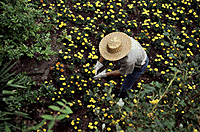Plantskydd is a proven effective rabbit repellent, and provides plants with up to 6 months of protection over winter on ornamental shrubs and 3 months on most other succulent broadleaf plants.
June Hutson, Missouri Botanical Garden
June Hutson is the Supervisor of the Kemper Demonstration Gardens at the Missouri Botanical Garden. She has worked at the facility for 27 years, in horticulture and currently as a field supervisor. She manages 8 acres of the 79-acre facility, where twenty-three distinct themed residential-scale gardens are exhibited at the Center for Home Gardening.
Hutson claims what is most difficult about her management position is “keeping the gardens in pristine condition at all times.” She notes that having rabbits and squirrels nibbling away at the displays does not make her job easier. The animals are attracted by tasty treats, such as of green beans, basil, cone flowers, balloon flowers and any species of violet.
The facility staff have had to be vigilant in watching for any signs of damage, and have been dedicated to “stopping [browse damage] before it takes a foothold.” This has been possible through “constant observation” and treating vulnerable plants prone to rabbit damage with Plantskydd Deer and Rabbit Repellent. When the directions are followed correctly, Hutson says animals will not return to the treated plant.
Rabbit repellents can be very effective in curbing the year-round browse damge. In the summer the animals feed on succulent green plants and in the winter on buds, twigs, and bark of trees and shrubs. Occasionally, rabbits eat the growing plants in home gardens. In winter they can destroy or injure ornamental shrubs, fruit trees, or berry bushes around the home. When applied properly, rabbit repellents will make the plants undesirable to the animals.
A recent study conducted by the National Wildlife Research Center investigating the efficacy of deer repellents concluded that:
- “…Studies investigating trends in efficacy of [animal] repellents indicate that, of the 20 products tested, repellents with active ingredients that emitted sulfurous odors i.e.: bloodmeal or egg solids, generally provided better results…
- “Products that contained active ingredients which cause pain/irritation (capsaicin, allyl isothiocyanate), or illness (thiram) were less effective…” (USDA/APHIS, Olympia, WA)
“The most notable reward [of effective plant protection] is that no animal was harmed and gardening with nature may be a possibility,” says Hutson. Obviously, because growing plants is our business and the public looks towards us to solve all problems, we are always on point. Our gardens can demonstrate how plants are eaten by animals, but is it up to us to show methods to control such activity.
September, 2003




